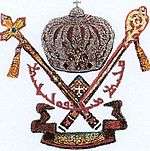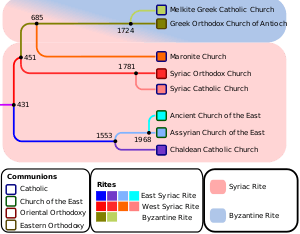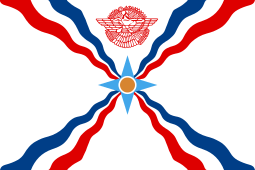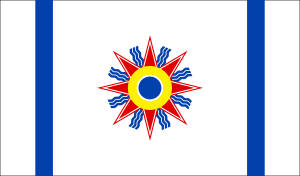Ancient Church of the East
The Ancient Church of the East (Syriac: ܥܕܬܐ ܥܬܝܩܬܐ ܕܡܕܢܚܐ ʿĒdtā ʿAttiqtā ḏMaḏnḥā; Arabic: كنيسة المشرق القديمة, Kanīsat al-Mašriq al-Qadīma), officially the Ancient Holy Apostolic Catholic Church of the East, is an Eastern Christian denomination founded by Thoma Darmo in 1968.
 Ancient Church of the East | |
|---|---|
| ܥܕܬܐ ܥܬܝܩܬܐ ܕܡܕܢܚܐ | |
| Classification | Eastern Christianity |
| Orientation | Syriac Christianity |
| Theology | Nestorianism |
| Primate | Catholicos-Patriarch Addai II Giwargis |
| Region | Iraq, Syria, with communities in Australia, New Zealand, United States, Canada, Sweden, Germany, United Kingdom, Denmark |
| Language | Syriac |
| Liturgy | East Syriac Rite |
| Headquarters | Baghdad, Iraq |
| Founder | Thoma Darmo |
| Origin | 1968 |
| Separated from | Assyrian Church of the East |
| Members | 70,000 in 1968[1] |
| Official website | http://www.stzaiacathedral.org.au |
The Ancient Church of the East distinguished itself from the Assyrian Church of the East in 1964. It is one of the Assyrian Churches that claim continuity with the historical Patriarchate of Seleucia-Ctesiphon – the Church of the East, one of the oldest Christian Churches in Mesopotamia.[2] The Church is headquartered in Baghdad, Iraq. In 1970, Catholicos-Patriarch Addai II Giwargis succeeded Thoma Darmo (1968–1969).
History
The Ancient Church of the East emerged as the result of a schism within the Assyrian Church of the East, in opposition to reforms introduced by Patriarch Shimun XXI Eshai of the Assyrian Church of the East, including the substitution of the modern Gregorian Calendar in place of the traditional Julian Calendar (which differs from the Gregorian by a widening number of days, currently thirteen). The Ancient Church of the East seated itself in Baghdad, Iraq, headed by a separate Catholicos-Patriarch.
Following the schism, the position of Catholicos-Patriarch of the Ancient Church of the East remained vacant from 1964 until 1968, when Mar Thoma Darmo was named the church's patriarch. Mar Thoma was elected as a rival Catholicos-Patriarch to Mar Eshai Shimun, who continued to serve as the official head of the Assyrian Church of the East headquartered in the United States. The elected Catholicos-Patriarch Mar Thoma was a native of Mesopotamia (present-day Iraq), and a former Metropolitan of the Assyrian Church of the East based in Thrissur, India. Mar Thoma served as Metropolitan from 1952 until his resignation in 1964. Upon becoming the head of the newly formed Ancient Church of the East, he immediately relocated to Baghdad.
Under the tenure of Mar Thoma Darmo
In September 1968, Mar Addai Giwargis was elevated to the rank of Metropolitan of Iraq. Similarly, Mar Aprem Mooken was consecrated Metropolitan of India, and Mar Poulose Poulose was consecrated Bishop of India. These prelates in turn consecrated Mar Thoma Darmo Catholicos-Patriarch of the Ancient Church of the East during the first week of October 1968. Mar Thoma then became the first Patriarch of the Ancient Church of the East. Mar Thoma served as Patriarch for just under a year before his death in September 1969.
Under the tenure of Mar Addai II
Following Patriarch Mar Thoma Darmo's death in 1969, Mar Addai II assumed the position of acting patriarch, and was later elected to lead the Ancient Church of the East in February 1970. In the meantime, he consecrated two Metropolitans, both in December 1969: Mar Narsai Toma was consecrated as Metropolitan of Kirkuk, and Mar Toma Eramia was consecrated Metropolitan of Nineveh (Mosul) and Northern Iraq. Mar Addai's official jurisdiction at the time was Baghdad.
Together, on February 20, 1972, Mar Narsai and Mar Toma consecrated Mar Addai Giwargis as Catholicos-Patriarch.
Expansion of the Holy Synod
In 1985, Mar Daniel Yakob, Bishop of Kirkuk of the Assyrian Church of the East was accepted into the Holy Synod of the Ancient Church of the East. He was to head the parishes in California, but ultimately served as an Auxiliary Bishop. In July 1992, Mar Yacoub Daniel was consecrated Bishop of Syria. The following year, in June 1993, Mar Emmanuel Elia was ordained Bishop of the Patriarchate of Baghdad. In 1994, however, Mar Emmanuel shifted his residence and became Bishop of North America and Canada.
In November and December 1995, the Ancient Church experienced several major changes. Mar Aprem Mooken and Mar Poulose Poulose, along with the Church of India, reunited with the Assyrian Church of the East for external reasons. During that same period, Timothaus Mar Shallita (Mar Shallita) was accepted into the Holy Synod and appointed Metropolitan of Europe, and Mar Yacoub Daniel was elevated to the rank of Metropolitan.
In July 2005, Mar Yacoub was transferred from Syria to Australia and New Zealand.
In April 2009, Mar Addai II consecrated Mar Zaia Khoshaba as Bishop of Baghdad. In the same month, he ordained Mar Aprem Daweed as Bishop of Duhok. In 2011, Mar Aprem resigned after serving just two years. 2011 also saw the resignation of Mar Emmanuel. In August 2011, Mar Yacoub Daniel and Mar Zaia Khoshaba consecrated Mar Mari Emmanuel as Bishop for Australia and New Zealand, assisting the Metropolitan.
Later Mar Addai II consecrated Mar Gewargis Younan as Bishop of Chicago, the youngest-serving prelate of the Ancient Church of the East.
In 2015, while the patriarchate of the Assyrian Church of the East was vacant following the death of Dinkha IV, the Chaldean Catholic Patriarch Louis Raphaël I Sako proposed a "merger" or reunion of his own Chaldean Catholic Church with both the Assyrian Church of the East and the Ancient Church of the East to (re-)create one united "Church of the East" with a single patriarch in full communion with the Pope.[3] The proposal did not go forward, and the Assyrian Church of the East elected a new patriarch of its own.
Organisation
The Ancient Church of the East recognizes the following nine positions in its hierarchy:
The Patriarch is the supreme head of the church, and oversees all dioceses of the church. The church has an episcopal polity, meaning it is organized into dioceses, each headed by a bishop. Dioceses are organized into Ecclesiastical provinces under the authority of a Metropolitan. Each diocese is made up of several parish communities. The individual parishes are staffed by at least one priest. Priests are assisted by Deacons, Subdeacons, and Readers. All members of the clergy may preach, baptize, witness marriages, and conduct funeral liturgies, though Deacons, Subdeacons, and Readers assume an assistant's role. Only those ranking above a deacon can celebrate the sacraments of the Eucharist, though others may be ministers of Holy Communion. Administering the sacrament of holy orders (ordaining someone into the clergy) is limited to bishops, metropolitans, and the Patriarch.
Holy Synod
- Mar Addai II, Catholicos-Patriarch of the East (seat in Baghdad)
- Mar Yacoub Daniel, Metropolitan of Australia and New Zealand (seat in Sydney, Australia)
- Mar Zaia Khoshaba, Metropolitan of North America and Europe (seat in Hamilton, Canada)
- Mar Gewargis Younan, Bishop of Chicago (seat in Chicago, USA)
Since January 2011 the synod of the Ancient Church of the East has split between those accepting the Patriarchate of Mar Addai II and those Old Calendarists rejecting it. The anti-patriarchal party is headed by Timothaus Mar Shallita. Individual parishes in Sweden, Denmark, United States and Australia adhere to these prelates:
- Mar Timothaus Shallita, Metropolitan (Mainz, Germany)
- Mar Toma Erimia Giwargis, Metropolitan (Hamilton, Canada)
- Mar Daniel Yakob, Bishop (Modesto, USA)
- Mar Mari Emmanuel, Bishop (Sydney, Australia)
List of Catholicos-Patriarchs of the Ancient Church of the East
Prior to 1964
In 1964, during the reign of Shemʿon XXI Eshai (also known as Mar Eshai Shimun XXIII), a schism occurred in the Church of the East causing the establishment of a separate Ancient Church of the East with its center in Baghdad. The Ancient Church of the East acknowledges the traditional lineage of the Patriarchs of the Church of the East in Babylon from Mar Shimun Keepa (Saint Peter)[4] until the schism of 1964.
The Ancient Church considers itself a true continuation of this lineage, and recognizes the Assyrian Church of the East as the same. This schism occurred because of the changing of the church calendar from the traditional Julian calendar to the Gregorian one, along with hereditary succession and tribal rivalry. Directly following the split from the Assyrian Church of the East, the seat of the Patriarch remained vacant for three years before a Patriarch was elected. In 1968 communities in Iraq, Syria and India elected a rival Patriarch centered in Baghdad, the then suspended Metropolitan of India Mar Thoma Darmo. He consecrated prelates who in turn consecrated him Patriarch. Currently the Patriarchate is located in Baghdad, Iraq.
Since 1964
- Vacant (1964 to 1967) – first period of the schism
- Mar Thoma Darmo (1968 to 1969)
- Vacant – Locum Tenens: Mar Addai II as Acting Patriarch (1969 to 1972)
- Mar Addai II Giwargis (1972 to present day)
Church of the East Old Calendarists
Various communities of Church of the East Old Calendarists seceded from the Ancient Church of the East in 2011 by continuing to observe the 25th of December on January 6th and 25th of March on April 6th, the Church of the East Calendar being 12 days behind the Gregorian calendar.
Relationship with the Assyrian Church of the East
The Ancient Church of the East was distinguished by its intent to maintain the traditions passed on by the Church of the East. The schism that divided the Church of the East into two parts resulted mainly from controversial changes introduced by Mar Shimun XXI Eshai. The most obvious of these was the decision to replace the traditional Julian Calendar with the Gregorian Calendar. Additionally, there were concerns raised in regard to the succession of the Patriarchate. The Patriarchate had been hereditary in the Mar Shimun family for six centuries, often resulting in the consecration of minors as head of the church. For example, the late Shimun XXI Eshai himself was ordained Patriarch at just twelve years old.[5]
Under the tenure of Mar Addai II, the Ancient Church of the East has made several gestures towards reunification with the Assyrian Church of the East. The most prominent of these is undoubtedly the declaration made in June 2010 stating that the Ancient Church of the East would now celebrate Christmas on December 25, in accordance with the Gregorian Calendar. Previously, the church recognized the Julian date (currently corresponding to January 7 on the Gregorian Calendar) each year as Christmas Day, as the Church of the East had for thousands of years. The decision was to be implemented later that year, on December 25, 2010.[6] This was the first time since the schism that the two churches celebrated the Christmas holiday on the same day. Despite this decision, many Church of the East Old Calendarists rejected the move so in an attempt to avert further dissent, the Holy Synod maintained that Easter would continue to be celebrated according to the Julian Calendar.
The declaration related to the celebration of Christmas was perceived as an attempt of reconciliation, and encouraged efforts for talks of reunification. A joint Holy Synod between the two churches was postponed, though is expected in the near future.
The international Assyrian community has long-since advocated for reunification, particularly in response to the 2014 and 2015 attacks launched against Assyrians in Iraq and Syria, respectively. Since that time, relations between the churches have improved on every level, particularly in the United States, Australia, New Zealand, and parts of Europe.
Dialogue for reunification
In early May 2015, following the death of Mar Dinkha IV, Catholicos-Patriarch of the Assyrian Church of the East, dialogue of unification resumed between the churches. Reunification of the two branches of the Church of the East was encouraged by the Patriarch. Following an informal meeting between Mar Gewargis Younan and Mar Paulus Benjamin, an official meeting request was delivered to Mar Aprem Mooken, acting Patriarch of the Assyrian Church of the East.
On May 22, 2015, a meeting involving prelates of both Holy Councils took place in a suburb of Chicago, Illinois, in the library of St. Andrew's Assyrian Church of the East. Present were Mar Yacoub Daniel, Mar Zaia Khoshaba, and Mar Gewargis Younan representing the Ancient Church of the East, and Mar Gewargis Sliwa, Mar Awa Royel, and Mar Iskhaq Yousif representing the Assyrian Church of the East. Archdeacon William Toma served as the meeting's common secretary. Mar Yacoub Daniel flew in from Australia for the meeting, and Mar Zaia traveled from Canada.
During the meeting, recommendations for unity between the Ancient Church of the East and Assyrian Church of the East were delivered through the selected representatives of each branch. The primary issues discussed were church leadership and the Holy Calendar. It was decided in this meeting that the individual Synods would meet separately to further discuss the terms. Another meeting between the two churches would then be scheduled to continue negotiations. It was requested by the Ancient Church of the East prelates that the election of the new Catholicos-Patriarch be delayed until negotiations had been concluded, in the hopes that a unified Synod would elect a successor together. In the event that the churches agree to reunify, Mar Addai II would be expected to resign. The Patriarch has already given his blessings, provided that the celebration of Easter Sunday in accordance with the traditional Julian Calendar is maintained.
On June 1, 2015, the Holy Synod of the Assyrian Church of the East met in Erbil, Iraq, to discuss the future of the church. The date had previously been arranged for the election of the new Catholicos-Patriarch. Mar Awa Royel issued a statement on the same day, notifying the public that a response to the Ancient Church of the East's recommendations for reunification had been delivered to their prelates. The letter requested a prompt response to the terms, and the election of the new Patriarch was suspended until the following week, on June 8, 2015. On June 2, 2015, Mar Gewargis Younan issued a statement on behalf of the Ancient Church of the East stating that a provisional decision had been reached to reunify the two branches. The statement dated June 2, 2015, also indicated that the Holy Synod of the Ancient Church planned to convene in the near future to issue a formal response.
On June 5, 2015, Mar Aprem Mooken issued a formal statement announcing that the election of the next Catholicos-Patriarch of the Assyrian Church of the East was suspended until September 27, 2015, pending the unification of the churches.
See also
- Church of the East
- Assyrian Church of the East
- East Syrian Rite
- List of Patriarchs of the Church of the East
- Chaldean Syrian Church in India (also known as Assyrian Church of the East in India)
- Syro-Malabar Catholic Church
- Chaldean Catholic Church
- Assyrian people
References
- Baumer, Christoph (2006). The Church of the East: An Illustrated History of Assyrian Christianity (1st ed.). London, England, United Kingdom: I.B. Tauris. p. 272. ISBN 1-84511-115-X.
- "CNEWA: Ronald G. Roberson, C.S.P. - The Assyrian Church of the East". Archived from the original on 2012-10-29. Retrieved 2011-06-20.
- "Chaldean Patriarch gambles on re-establishing 'Church of the East'” La Stampa 25 June 2015. Accessed 11 May 2017.
- 1 Peter 5:13
- Biography of His Holiness, The Assyrian Martyr, The Late Mar Eshai Shimun XXIII
- The Assyrian: Ancient Church of the East moves to change calendar Archived 2015-05-07 at the Wayback Machine
Sources
- Mar Aprem Mooken, The Assyrian Church of the East in the Twentieth Century. Mōrān ’Eth’ō, 18. (Kottayam: St. Ephrem Ecumenical Research Institute, 2003).
- Bishop James Hess, Nestorian Apostolic Bishop, "Bishops at Large", by Bishop Alan Bain published in the UK. 1985
- Most Rev James H Hess, "A Directory of Autocephalous Bishops" by Bishop Karl Pruter, St Willibrord Press, USA, 1985
- Rev George Badger (Anglican priest and protégé of the Archbishop of Canterbury), "Nestorians and Their Rituals", published by Oxford University c. 1860.
- The Thirty Nine Articles of the Church of England, as published in the Book of Common Prayer of the Church of England, Cambridge University Press, 1968
- "The Pearl (Marganitha), On The Truth of Christianity" Written in 1298 AD by Mar Odisho, Metropolitan of Suwa and Armenia. Translated and published in English by the late Patriarch, Shimun (Simon) XXIII, in 1964.





